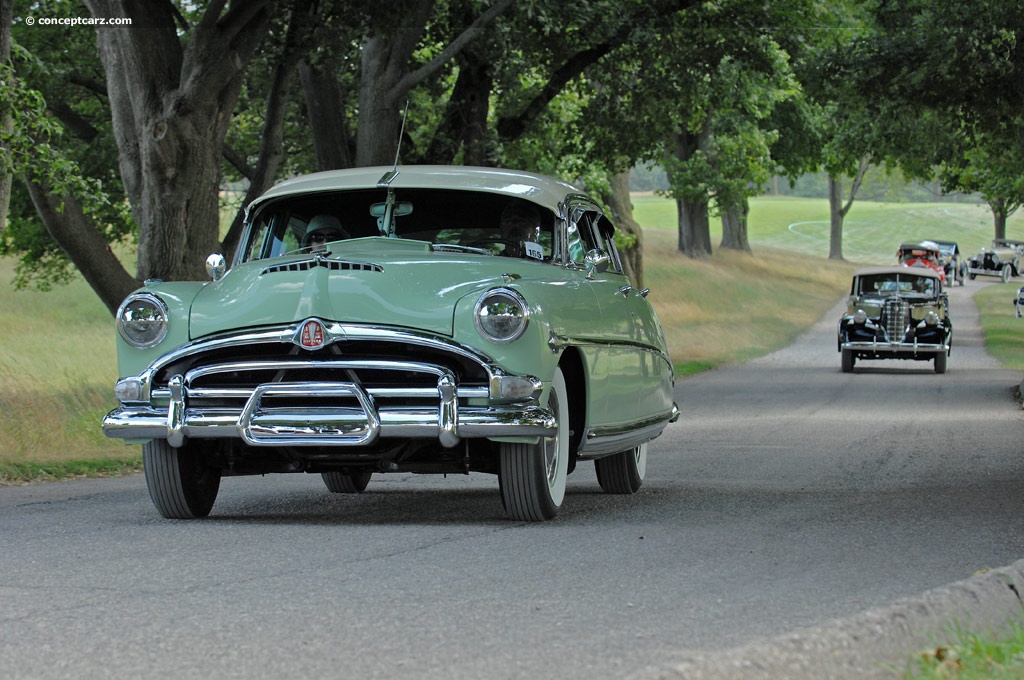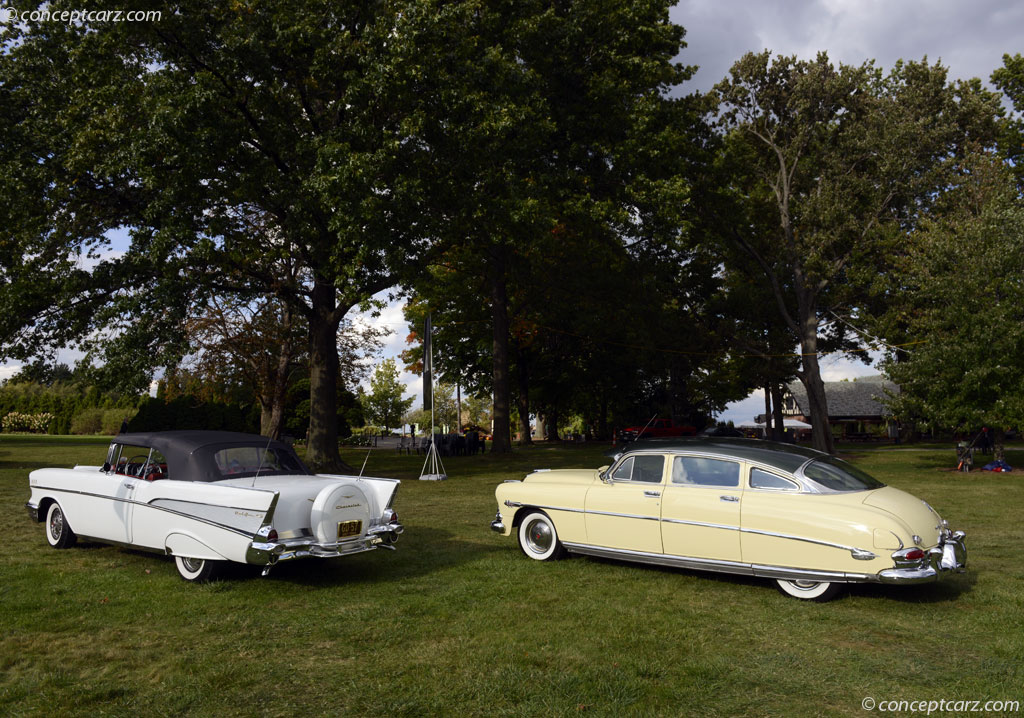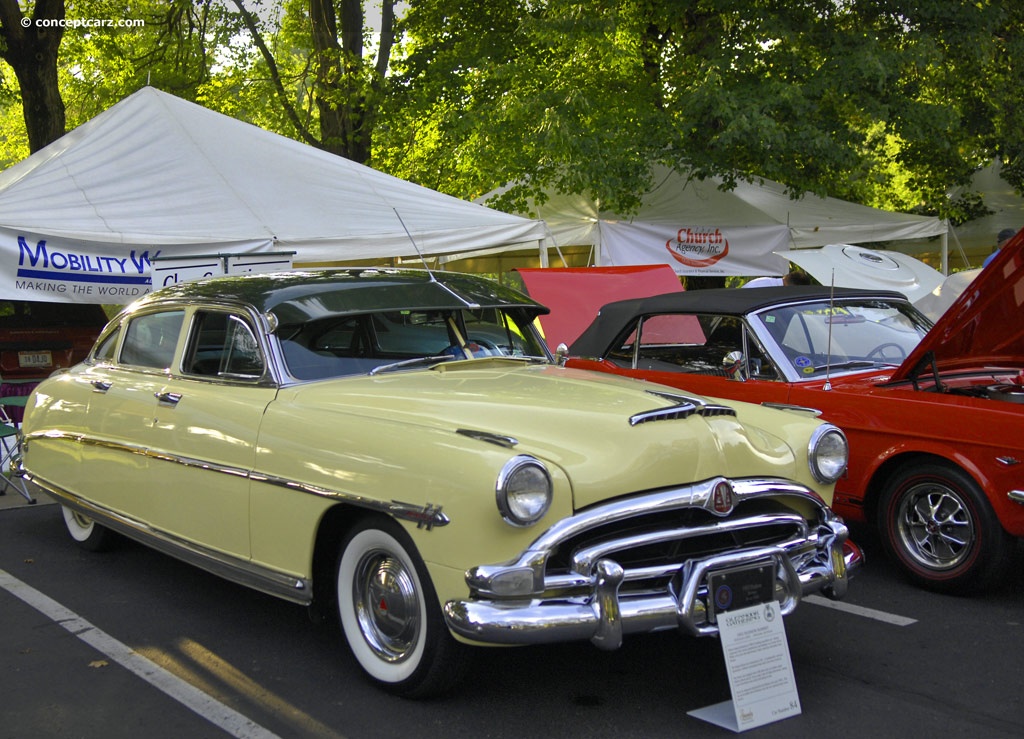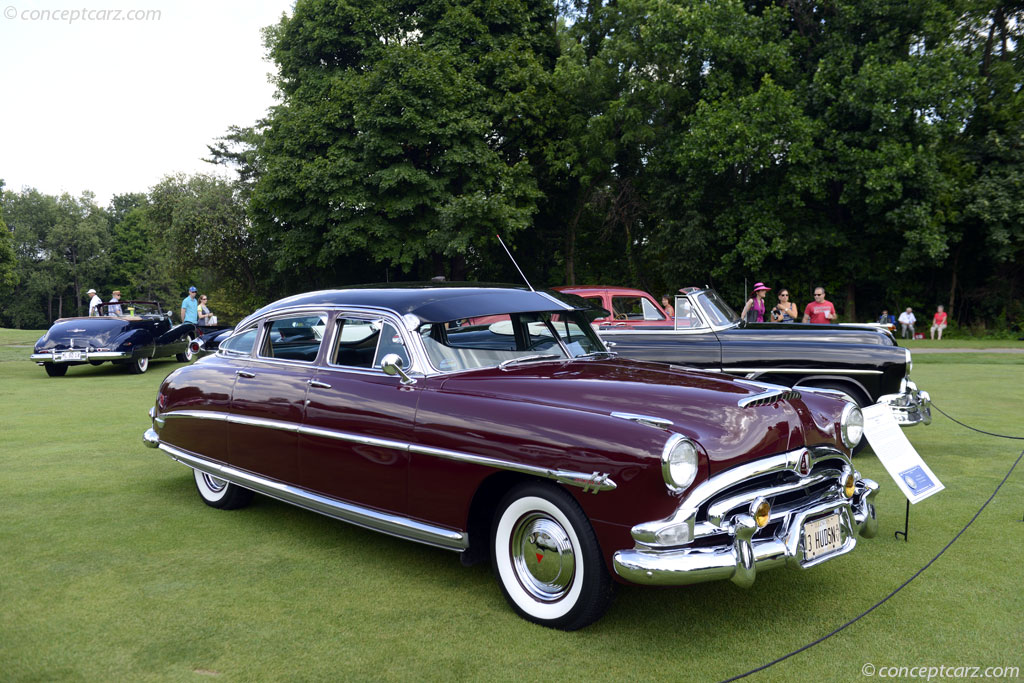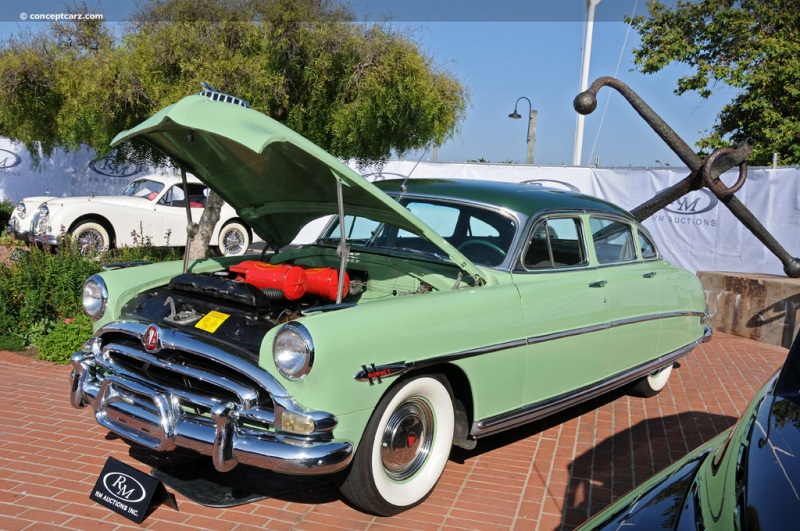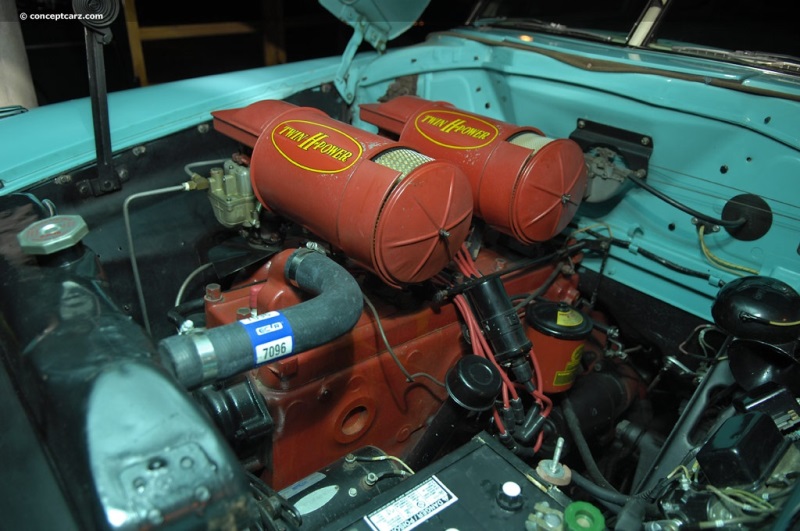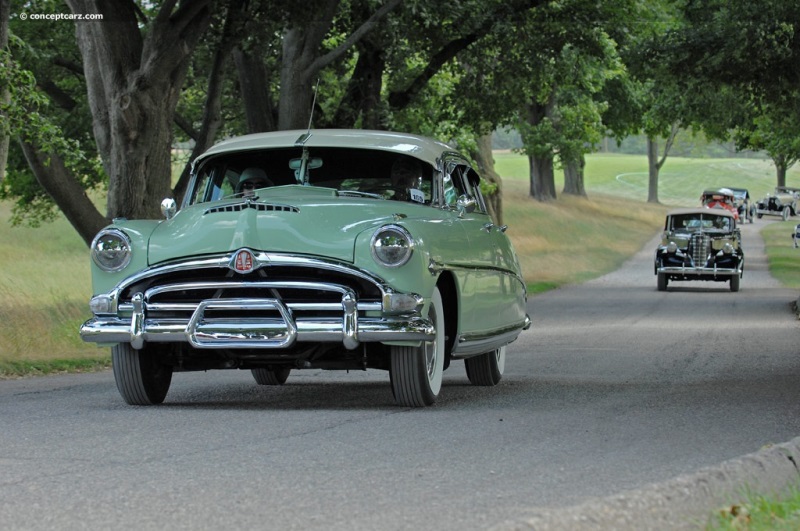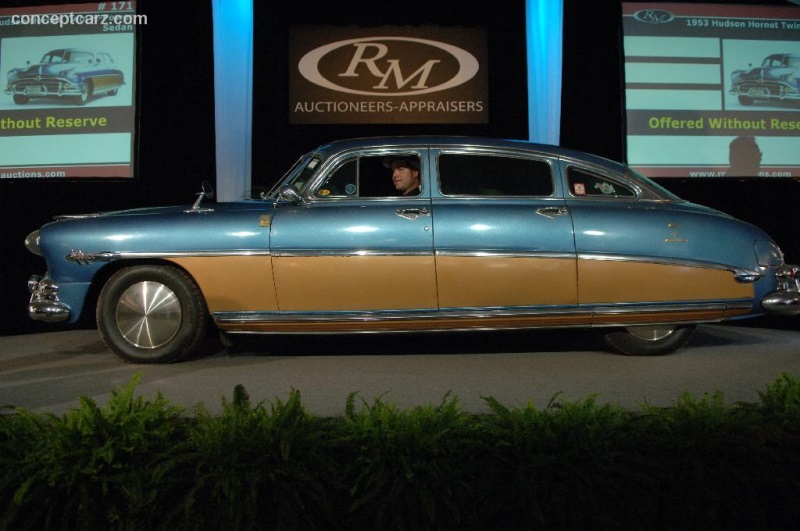Hudson unveiled its landmark 'Step Down' models in 1948, beating Detroit's Big Three to market all-new car designs and becoming one of the first American car manufacturers to offer a new product in the post-World War II. The Hudson Hornet was introduced in September 1950 for the 1951 model year and shared its innovative unit-type body shell construction and 124-inch wheelbase chassis with the top-line Commodore. It wore sleek styling, had a low center of gravity, and impressive road handling characteristics. Beneath its bonnet was a prewar-style flathead engine whose basic design had been updated near the close of the 1940s. Displacing 308 cubic inches, the venerable straight-six engine offered 145 horsepower in standard guise. A choice of manual, overdrive, and automatic transmissions was available. 
Hollywood HardtopThe 'step down' chassis design had a floor placed low inside the perimeter of the frame, allowing the car to be drastically lower than anything else on the road. This design accommodated stoner and lighter-weight bodies, features that paid dividends with Hudson's racing program, helping them dominate NASCAR racing in the early 1950s. 1951
- the Hornet won 12 of 41 NASCAR Grand National races; drivers included Marshall Teague, Herb Thomas, Tim Flock, and Dick Rathmann.
1952
- the Hornet won 40 of 48 major stock-car races.
- the Hornet won 48 first-place finishes and came in second 23 times.
- Hudson won 27 of the 34 NASCAR Grand National races
- Teague won 12 of the 13 scheduled events and finished the AAA season with a 1000-point lead over his closest rival.1953
- the Hornet won 22 major NASCAR Grand National races
- 13 wins in AAA competition.
Hollywood Hardtop1954
- the Hornet won 17 of the 37 NASCAR Grand National racesThe Hudson Hornet was produced from 1951 until 1957 (from 1951 to 1954 by Hudson; after the merger forming AMC in 1954, Hudson Hornets were restyled Nash automobiles that were badge engineered as a Hudson.)Mechanical Specification
The Hudson Hornet (1951 to 1954) rested on a 124-inch wheelbase and had a length of 208 inches, a width of 77.5 inches, and a height of 60 inches. The 1954 to 1957 Hornet used a 121.25-inch wheelbase with a 209-inch length, a width of 78 inches, and a height of 60 inches. The Hornet 'Special' of mid-1956 had a 114.25-inch wheelbase and a length of 202 inches.The high-compression 'H-145' straight-6 engine, based on the company's previous 262 CID 'Super Six' was bored and stroked to 308 cubic inches and given a high-chromium-alloy block. Beginning in mid-1951 as a dealer-installed option at the cost of $85.60, the engine was optioned with 'Twin H-Power' that included twin one-barrel Carter carburetors, improved fuel distribution, and increased throat area. In 1952, this option could be ordered from the factory. The two-barrel carburetor engine specification produced 145 horsepower at 3,800 RPM and 275 lb-ft of torque.Hudson's L-head, 308 cubic-inch engine holds the distinction of being the largest displacement six-cylinder engine used in mass-production cars at the time. Output increased to 170 hp by 1954, and was tunable to even higher power output by precision tuners, including Marshall Teague. A 7-X version of the engine, offered as a factory option beginning in 1954, included a high compression head, special camshaft, and other modifications that brought horsepower to 210 hp. The 308 cubic-inch engine was renowned for its fairly flat torque curve, its high torque production at low RPMS, and the amount of power it produced compared to its contemporary low-priced competition. The engine offered 100 mph speeds and was capable of achieving 17 mph fuel economy.
Sedan
Chassis #: 7C222260
Auction entries : 1The low-priced Hornet Special was introduced in mid-1956 and was equipped with AMC's new 250 cubic-inch V8 engine rated at 190 horsepower. They were built on a 7-inch shorter wheelbase platform and wore the Statesman/Wasp four-door sedan and two-door hardtop bodies with Hornet trim.Production
First Generation
1951: 43,666
1952: 35,921 (approximately 2,160 hardtops and 360 convertibles)
1953: 27,207 (approximately 910 Hollywood hardtops)
1954: 24,833 Second Generation
1955: 13,334 (10,010 four-door sedans and 3,324 Hollywood two-door hardtops)
1956: 8,152 (6,512 four-door sedans and 1,640 Hollywood two-door hardtops)
1957: 4,108 (3,359 sedans and 749 Hollywood hardtops)Body Styles
1951 to 1954
- four-door sedan
- two-door coupe
- pillarless hardtop coupe
- convertible (a.k.a. Convertible Brougham) 1955 to 1957
- four-door sedan
- two-door hardtop
The 1951 Hudson model lineup included the 'entry-level' Pacemaker on a short (119-inch) wheelbase and powered by a smaller (232 CID) inline six. Prices ranged from $1,965 to $2,145. These were the company's most popular models with production reaching 34,495 units.Besides the Pacemaker, all 1951 Hudson's had a 123.8-inch wheelbase platform and a length of 208.5 inches. The Super Custom shared its six-cylinder (262 CID) engine with the Commodore and was priced from $2,240 to $2,830. It had a nearly identical list of body styles as the Pacemaker including a sedan, brougham, club coupe, and convertible brougham. The Pacemaker could be purchased as a 3-passenger coupe and the Super Custom had a 2-door, 6-passenger Hollywood Hardtop. The Super Custom's list of standard equipment was identical to the Pacemaker. A total of 22,532 examples of the Super Custom Sixes were built.The Commodore could be purchased with the 262 CID inline-6 or 254 CID inline-8. Eight-cylinder powered Commodores were priced similarly to the new range-topping Hornet. Six-cylinder Commodores were priced from $2,450 to $3,000. The eight-cylinder versions ranged from $2,550 to $3,100. Body styles included a sedan, club coupe, Hollywood hardtop, and a convertible brougham. A total of 31,222 examples were built (16,979 with six-cylinder power; 14,243 with eight-cylinder power)The Hornet was the new top-of-the-line Hudson and was powered by a high-performance 308 cubic-inch, L-head inline-6 delivering 145 horsepower. The list of Body styles were identical to the Commodore and its prices were the same as the eight-cylinder Commodore. A total of 43,666 examples were built making it Hudson's most popular model in 1951.
The 1952 Hudson model lineup consisted of the Pacemaker (Wasp), Commodore, and the Hornet. The Pacemaker and Hornet were solely offered with six-cylinder power, while the Commodore could be purchased with six- or eight-cylinder power. All three models were offered in 2- and 4-door body styles with open and closed configuration.
Sedan
Chassis #: 7C222260
Auction entries : 11952 Pacemaker/Wasp:
- $2,115 to $3,050
- 232 inline-6 with 112 hp
- optional 262 CID inline-6 with 127 hp
- 119-inch wheelbase
- 29,364 examples built (7,486 Pacemakers; 21,878 Wasps)1952 Hornet:
- $2,720 to $3,320
- 308 CID inline-6 with 145 hp
- 124-inch wheelbase
- 35,921 examples built1952 Commodore:
- $2,650 to $3,350
- 124-inch wheelbase
- 262 CID inline-6 with 127 hp
- 254 CID inline-8 with 128 hp
- 4,717 examples built (1,592 with six-cylinders; 3,125 with eight-cylinders)
1953 was the final year Hudson operated as an independent manufacturer.
Sedan
Chassis #: 216678
View info and history
Auction entries : 2The 'buzz' around Hudson's 1953 models was 'super!' Models included the Jet and Super Jet, Wasp and Super, and the Hornet and each had its own unique wheelbase size (The 'Super' was an option on both the Jet and Wasp adding additional standard equipment, trim and amenities). The Jet was the smallest at 105 inches, the Wasp at 119 inches, and the Hornet at 124 inches. The 'compact' Jet was priced at $1,860 for the sedan and $1,930 for the coupe sedan (the latter solely offered as a Super Jet). A total of 21,143 examples of the combined Jet and Super Jet were built in 1953. The Wasp was Hudson's mid-size automobile for 1953, offered as a 2- and 4-door sedan, club coupe, Hollywood hardtop, and convertible brougham. Prices began at $2,310 and rose to $3,050. The L-head inline six-cylinder engine had a Carter one-barrel carburetor and four main bearings and produced 112 horsepower at 4,000 RPM. This engine had previously been used to power the Pacemaker Six. A total of 17,792 examples of the Wasp and Super Wasp were produced in 1953. The Hudson Hornet was well established within the industry by 1953, having proven itself on racetracks and in the salesroom. Priced at the top of the company's spectrum, it was the company's most popular model in 1952, 1953, and 1954. Styling remained consistent with the previous year highlighted by the iconic 'Flying-H' identification on the sides of the front fenders, gold and chrome hood mascot, and Hornet medallions on the front door valance panels. Updates included the removal of the previous strut bar from the grille, and the addition of a non-functional air scoop hood ornament. 
Sedan
Auction entries : 1The high-performance L-head inline six-cylinder engine had a chrome alloy block, 'Power Dome' aluminum cylinder head, solid valve lifters, a Carter two-barrel carburetor, four main bearings, and 7.2:1 compression. Its bore measured 3.8 inches, and its stroke was 4.5 inches. Its 145 horsepower at 3,800 RPM was sent to the rear wheels via a standard three-speed manual transmission. Overdrive was optional, as was a HydraMatic automatic. Among the list of standard equipment were large hubcaps, foam seat cushions, hydraulic window regulators (convertible), an electric clock, front rectangular bumper guards, front outer bumper guards, and a three-spoke steering wheel. Optional equipment included direction indicator ($24), cigar lighter ($4), back-up lights ($24), six-tube manual radio ($82), eight-tube push-button radio ($100), outside rearview mirror ($6), Remote control Weather Control heater ($74), windshield washer ($11), two-tone paint combinations ($31), oil filter ($14), overdrive ($111), and the high-performance 7-X engine from Hudson Dealer Parts Department ($385). The four-door, six-passenger Hornet sedan was priced at $2,770, the two-door club coupe at $2,740, the 2-door Hollywood hardtop at $3,100, and the convertible brougham at $3,340. A total of 27,208 examples of the Hornet were built in 1953, including approximately 910 Hollywood two-door hardtops.
Hudson Motor Car Co. became a division of American Motors Corp on May 1, 1954. The 1954 Hudson model lineup included the Jet, Super Jet, Wasp Hornet, Italia, and Metropolitan (the Metropolitan had been previously marketed as a Nash in the United States). The Italia was a very low-production halo model built on the Jet platform. Just 27 examples were produced with the 2-door sport coupe priced at $4,800. It wore aluminum coachwork, coachwork by Carrozzeria Touring of Milan, Italy, and powered by a 201.5 cubic-inch inline-6 with 114 horsepower. The total production of 1954 Hudson Hornets was $24,833. Prices began at $2,570 and increased to $3,290. Body styles included a sedan, club sedan, club coupe, Hollywood Hardtop, and convertible brougham.
by Daniel Vaughan | Jun 2009
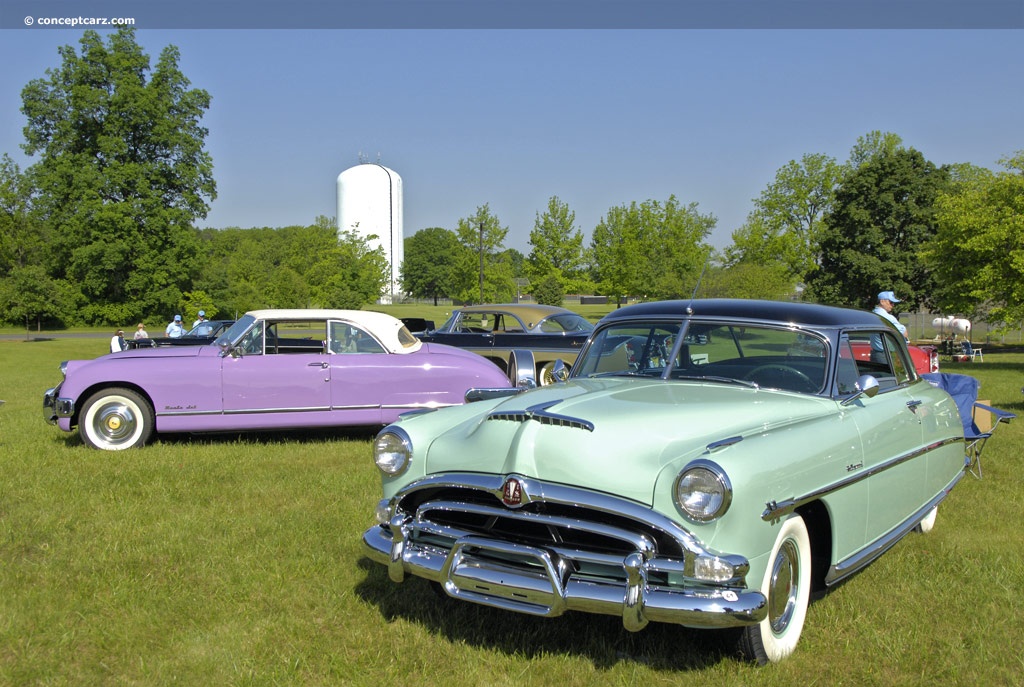
Hollywood Hardtop
- the Hornet won 12 of 41 NASCAR Grand National races; drivers included Marshall Teague, Herb Thomas, Tim Flock, and Dick Rathmann.
1952
- the Hornet won 40 of 48 major stock-car races.
- the Hornet won 48 first-place finishes and came in second 23 times.
- Hudson won 27 of the 34 NASCAR Grand National races
- Teague won 12 of the 13 scheduled events and finished the AAA season with a 1000-point lead over his closest rival.1953
- the Hornet won 22 major NASCAR Grand National races
- 13 wins in AAA competition.
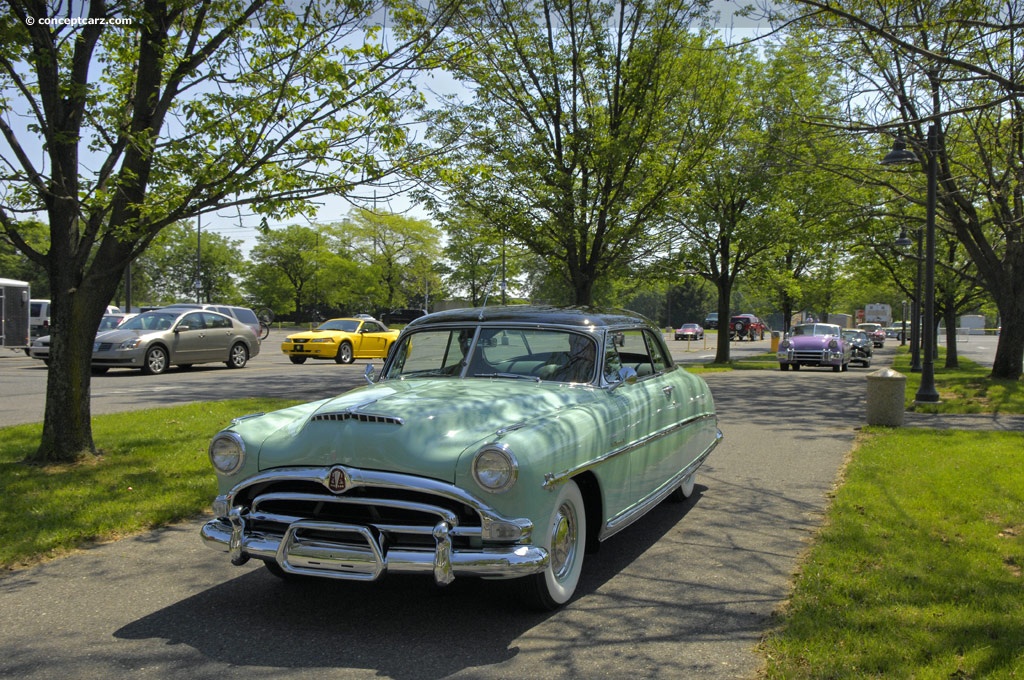
Hollywood Hardtop
- the Hornet won 17 of the 37 NASCAR Grand National racesThe Hudson Hornet was produced from 1951 until 1957 (from 1951 to 1954 by Hudson; after the merger forming AMC in 1954, Hudson Hornets were restyled Nash automobiles that were badge engineered as a Hudson.)Mechanical Specification
The Hudson Hornet (1951 to 1954) rested on a 124-inch wheelbase and had a length of 208 inches, a width of 77.5 inches, and a height of 60 inches. The 1954 to 1957 Hornet used a 121.25-inch wheelbase with a 209-inch length, a width of 78 inches, and a height of 60 inches. The Hornet 'Special' of mid-1956 had a 114.25-inch wheelbase and a length of 202 inches.The high-compression 'H-145' straight-6 engine, based on the company's previous 262 CID 'Super Six' was bored and stroked to 308 cubic inches and given a high-chromium-alloy block. Beginning in mid-1951 as a dealer-installed option at the cost of $85.60, the engine was optioned with 'Twin H-Power' that included twin one-barrel Carter carburetors, improved fuel distribution, and increased throat area. In 1952, this option could be ordered from the factory. The two-barrel carburetor engine specification produced 145 horsepower at 3,800 RPM and 275 lb-ft of torque.Hudson's L-head, 308 cubic-inch engine holds the distinction of being the largest displacement six-cylinder engine used in mass-production cars at the time. Output increased to 170 hp by 1954, and was tunable to even higher power output by precision tuners, including Marshall Teague. A 7-X version of the engine, offered as a factory option beginning in 1954, included a high compression head, special camshaft, and other modifications that brought horsepower to 210 hp. The 308 cubic-inch engine was renowned for its fairly flat torque curve, its high torque production at low RPMS, and the amount of power it produced compared to its contemporary low-priced competition. The engine offered 100 mph speeds and was capable of achieving 17 mph fuel economy.
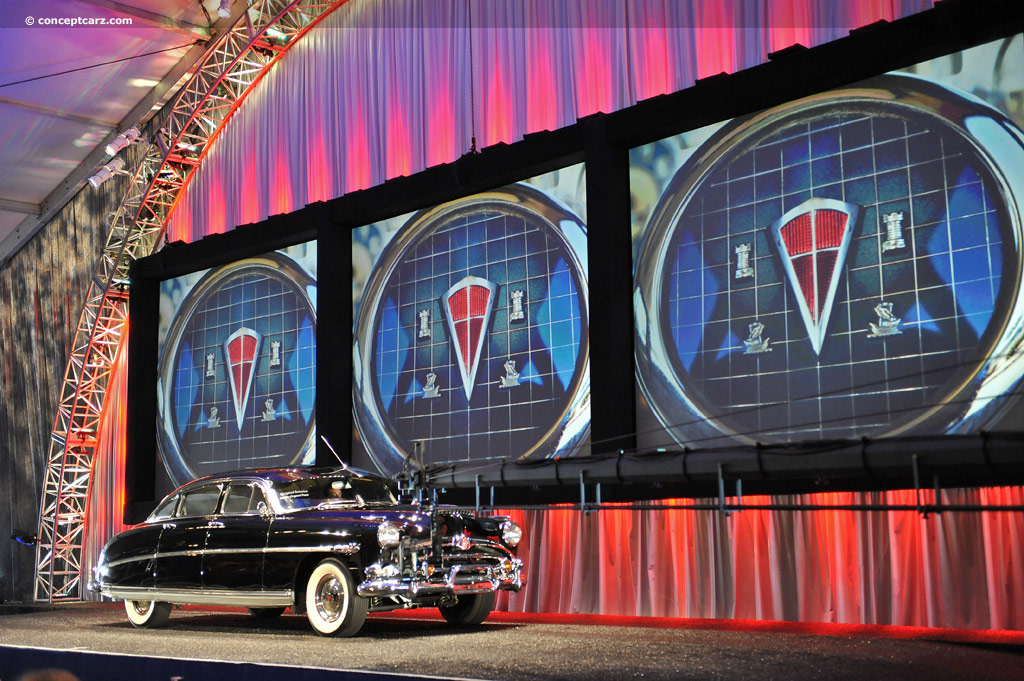
Sedan
Chassis #: 7C222260
Auction entries : 1
First Generation
1951: 43,666
1952: 35,921 (approximately 2,160 hardtops and 360 convertibles)
1953: 27,207 (approximately 910 Hollywood hardtops)
1954: 24,833 Second Generation
1955: 13,334 (10,010 four-door sedans and 3,324 Hollywood two-door hardtops)
1956: 8,152 (6,512 four-door sedans and 1,640 Hollywood two-door hardtops)
1957: 4,108 (3,359 sedans and 749 Hollywood hardtops)Body Styles
1951 to 1954
- four-door sedan
- two-door coupe
- pillarless hardtop coupe
- convertible (a.k.a. Convertible Brougham) 1955 to 1957
- four-door sedan
- two-door hardtop
1951 Hudson Models
The 1951 Hudson model lineup included the 'entry-level' Pacemaker on a short (119-inch) wheelbase and powered by a smaller (232 CID) inline six. Prices ranged from $1,965 to $2,145. These were the company's most popular models with production reaching 34,495 units.Besides the Pacemaker, all 1951 Hudson's had a 123.8-inch wheelbase platform and a length of 208.5 inches. The Super Custom shared its six-cylinder (262 CID) engine with the Commodore and was priced from $2,240 to $2,830. It had a nearly identical list of body styles as the Pacemaker including a sedan, brougham, club coupe, and convertible brougham. The Pacemaker could be purchased as a 3-passenger coupe and the Super Custom had a 2-door, 6-passenger Hollywood Hardtop. The Super Custom's list of standard equipment was identical to the Pacemaker. A total of 22,532 examples of the Super Custom Sixes were built.The Commodore could be purchased with the 262 CID inline-6 or 254 CID inline-8. Eight-cylinder powered Commodores were priced similarly to the new range-topping Hornet. Six-cylinder Commodores were priced from $2,450 to $3,000. The eight-cylinder versions ranged from $2,550 to $3,100. Body styles included a sedan, club coupe, Hollywood hardtop, and a convertible brougham. A total of 31,222 examples were built (16,979 with six-cylinder power; 14,243 with eight-cylinder power)The Hornet was the new top-of-the-line Hudson and was powered by a high-performance 308 cubic-inch, L-head inline-6 delivering 145 horsepower. The list of Body styles were identical to the Commodore and its prices were the same as the eight-cylinder Commodore. A total of 43,666 examples were built making it Hudson's most popular model in 1951.
1952 Hudson Models
The 1952 Hudson model lineup consisted of the Pacemaker (Wasp), Commodore, and the Hornet. The Pacemaker and Hornet were solely offered with six-cylinder power, while the Commodore could be purchased with six- or eight-cylinder power. All three models were offered in 2- and 4-door body styles with open and closed configuration.
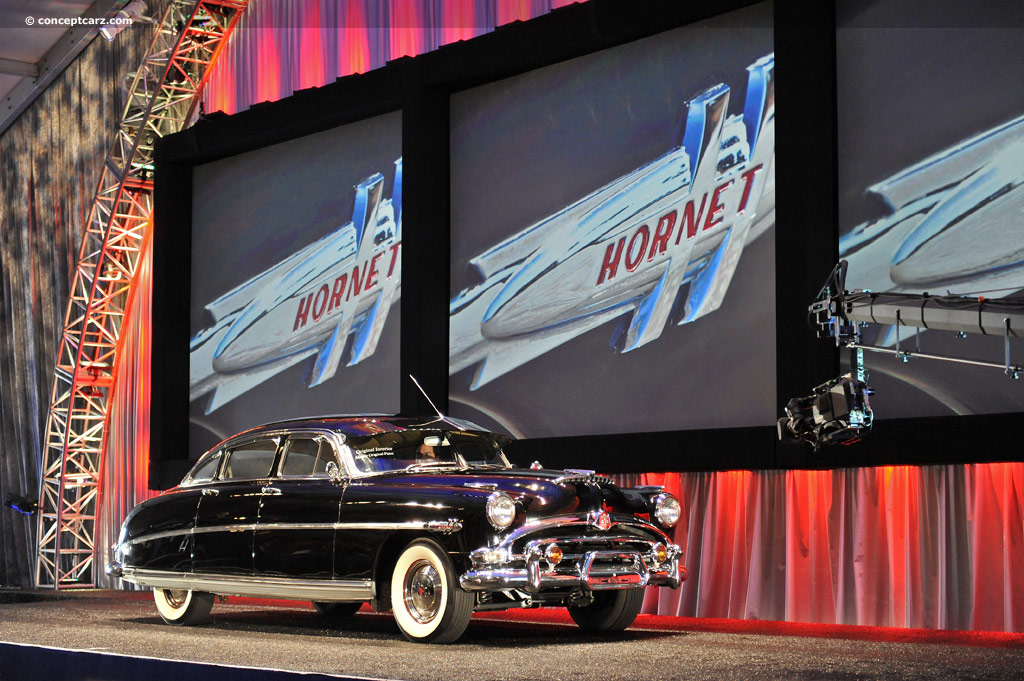
Sedan
Chassis #: 7C222260
Auction entries : 1
- $2,115 to $3,050
- 232 inline-6 with 112 hp
- optional 262 CID inline-6 with 127 hp
- 119-inch wheelbase
- 29,364 examples built (7,486 Pacemakers; 21,878 Wasps)1952 Hornet:
- $2,720 to $3,320
- 308 CID inline-6 with 145 hp
- 124-inch wheelbase
- 35,921 examples built1952 Commodore:
- $2,650 to $3,350
- 124-inch wheelbase
- 262 CID inline-6 with 127 hp
- 254 CID inline-8 with 128 hp
- 4,717 examples built (1,592 with six-cylinders; 3,125 with eight-cylinders)
1953 Hudson Models
1953 was the final year Hudson operated as an independent manufacturer.
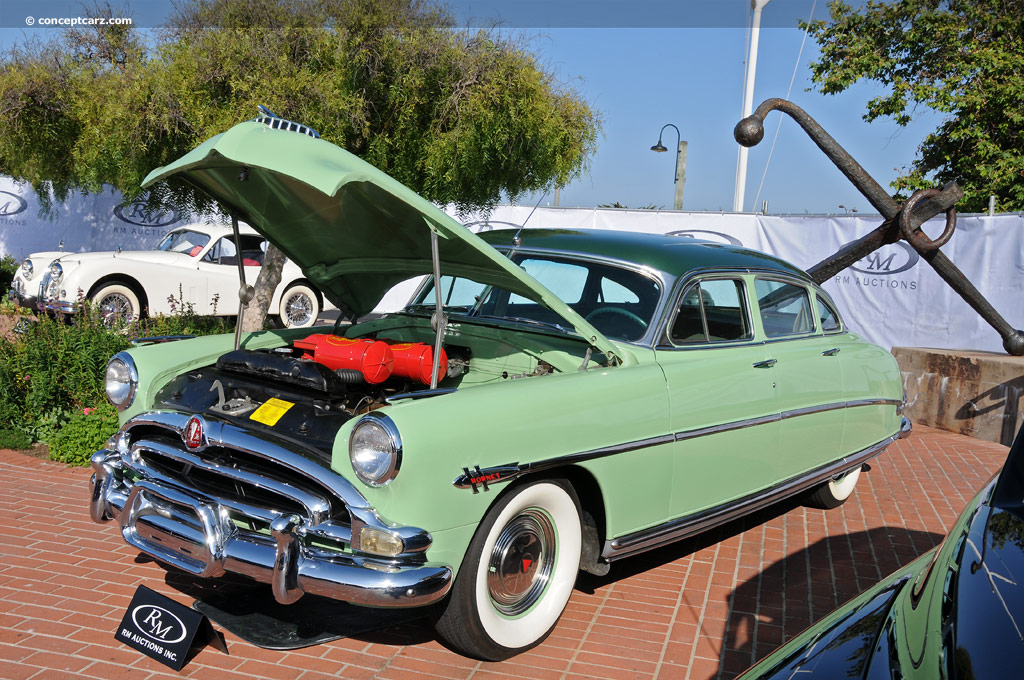
Sedan
Chassis #: 216678
View info and history
Auction entries : 2
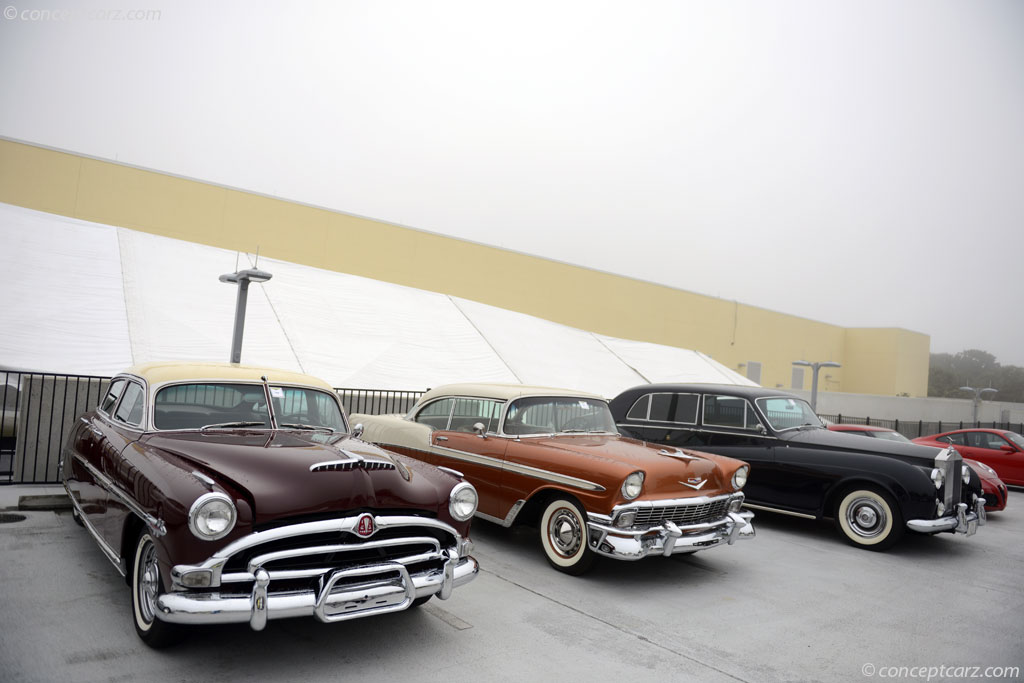
Sedan
Auction entries : 1
1954 Hudson Models
Hudson Motor Car Co. became a division of American Motors Corp on May 1, 1954. The 1954 Hudson model lineup included the Jet, Super Jet, Wasp Hornet, Italia, and Metropolitan (the Metropolitan had been previously marketed as a Nash in the United States). The Italia was a very low-production halo model built on the Jet platform. Just 27 examples were produced with the 2-door sport coupe priced at $4,800. It wore aluminum coachwork, coachwork by Carrozzeria Touring of Milan, Italy, and powered by a 201.5 cubic-inch inline-6 with 114 horsepower. The total production of 1954 Hudson Hornets was $24,833. Prices began at $2,570 and increased to $3,290. Body styles included a sedan, club sedan, club coupe, Hollywood Hardtop, and convertible brougham.
by Daniel Vaughan | Jun 2009
Related Reading : Hudson Hornet History
The Hudson Motor Car Company came into existence in 1909 and produced vehicles until 1957. It was created by Howard Coffin, George W. Dunham, and Roy E. Chapin. Based in Detroit, Michigan, the company had its most successful year in 1929, when it produced and sold over 300,000 vehicles. From 1942 through 1945, the Hudson Corporation did its patriotic part by manufacturing war materials, such as naval....
Continue Reading >>
Continue Reading >>
Similar Automakers
Similarly Sized Vehicles
from 1953
Similarly Priced Vehicles
- Austin-Healey 100 ($3,000-$3,000)
- Chrysler Windsor ($2,552-$3,285)
- Kaiser Manhattan ($2,595-$2,750)
- Oldsmobile Ninety-Eight ($2,550-$5,717)
- Buick Series 70 Roadmaster ($3,350-$5,000)
- Packard Clipper Deluxe ($2,691-$2,730)
- Pontiac Chieftain ($1,960-$2,800)
- DeSoto Firedome ($2,715-$3,542)
- Lincoln Cosmopolitan ($3,225-$3,290)
Average Auction Sale: $57,020
1953 Hudson Hornet Vehicle Profiles
Recent Vehicle Additions
Performance and Specification Comparison
Price Comparison
$2,265 - $3,050
$4,800
Hornet Specification Comparison by Year
Year
Production
Wheelbase
Engine
Prices
27,208
124.00 in.
6 cyl., 308.00 CID., 145.00hp
6 cyl., 308.00 CID., 240.00hp
6 cyl., 308.00 CID., 240.00hp
$2,740 - $3,340
Related Automotive News

Broad Arrow Announces Early Highlights For The Official Auction Of The Amelia
1961 Mercedes-Benz 300 SL Disc Brake Roadster finished in a stunning metallic blue with complementary maroon leather interior headlines an initial group of tour-ready post-war sports and classic cars set for The Amelia Auction....

99% of consignments find new homes at Worldwide's Enthusiast Auction in Auburn, Indiana, including two outstanding collections
Worldwide conducted its second successful live sale of the year on April 23-24 at its company headquarters in Auburn, Indiana, with 99 of consignments finding new homes at The Enthusiast Auction, including two outstanding collections. Among the highlights...

TOP 10 CARS GOING UNDER THE HAMMER AT PARIS MOTOR SHOW AUCTION
Important entries include the first Ferrari Dino delivered to France, Liberaces gold plated Cadillac, unique artwork by Natacha Toutain and more
Le Mans 2017 Ultra-VIP package to be auctioned for charity
Coys joins exciting new social platform
I...

RAM TRUCK TO SHOWCASE OFF-ROAD TRUCK LEADERSHIP AT 2016 OVERLAND EXPO
Overland Expo to host Ram Truck press conference and owner clinic
Fresh off their Chicago Auto Show unveiling, new 2017 Ram Power Wagon and Ram 2500 4x4 Off-road pickups will make their first Arizona appearance at the Overland Expo in Mormon Lake,...

Magnificent Series of Coachbuilt Classics To Grace RM's Amelia Island Concours D'Elegance Sale
RM Auctions returns as the official auction house of the Amelia Island Concours dElegance, March 9, 2013
Single-day sale features breathtaking roster of more than 80 investment-quality collector cars
Notable highlights include an outstanding s...
